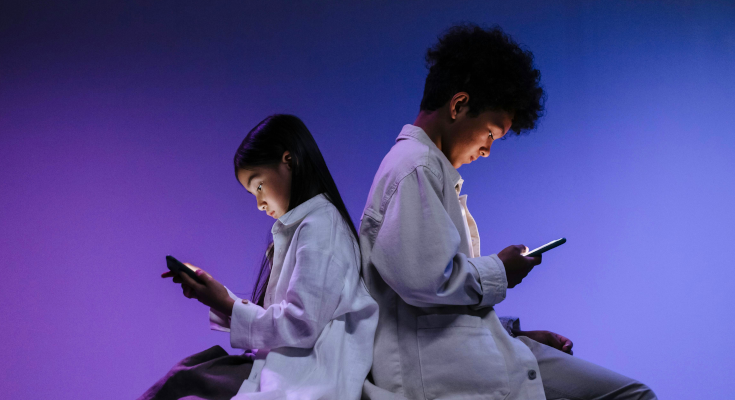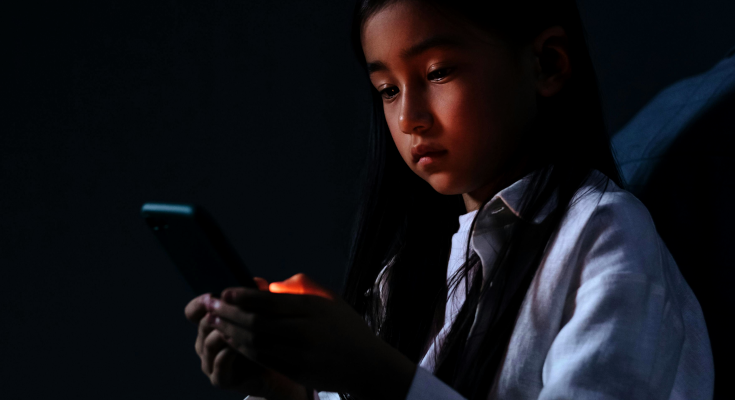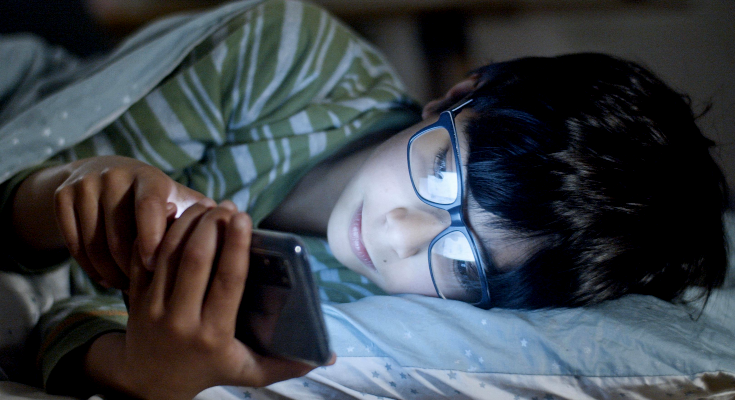Are non smartphones the solution? Discover the shocking truths about screen time and why some experts argue for a ban on smartphones for children under 16.
My 12-year-old cousin Rishi was immersed in his smartphone on the couch. I said, “Hey Rishi,” attempting to catch his attention. “Shouldn’t you take a break from that thing? I think its hightime you should be introduced to non smartphones.”
With his eyes fixed on the TV, Rishi hardly raised an eyebrow. Grumbling under his breath, “I’m almost done with this level,” he tapped away.
I sighed, simultaneously feeling worried and frustrated.
“Rishi, you’ve been using that for hours. Do you not believe that a break is in order?“
At last, he pulled his eyes from the television and gave me a grumpy look. “Why? What’s so important?
I couldn’t resist pondering: Does this little gadget cause more harm than good? Like many others, I’m concerned about how cellphones will affect our kids. This concern led me to explore whether children under 16 should be banned from using smartphones. Let’s dive into this topic together.
Content Overview
Summary of Key Arguments

Several studies have explored the impact of smartphone usage on children’s health and development. A study by Twenge and Campbell (2018) in Clinical Psychological Science found that adolescents who spent more time on electronic devices were more likely to report mental health issues . Similarly, a study in (Journal of the American Medical Association) JAMA Pediatrics indicated that high screen time is associated with developmental delays in young children.
Research by the Royal College of Paediatrics and Child Health (RCPCH) suggests that while moderate use of screens is unlikely to cause significant harm, excessive use is linked to negative health outcomes. The RCPCH recommends setting boundaries and ensuring screen time does not interfere with sleep, physical activity, and face-to-face interactions.
Smartphones: Hidden Dangers for Kids
1) Physical Health Concerns
There are several physical health issues that can arise from excessive screen usage. Rishi, for example, frequently laments his dry eyes and headaches. The blue light from screens exacerbates these symptoms of digital eye strain, according to the American Optometric Association. Furthermore, obesity is a result of spending too much time on a smartphone while relaxing. According to the World Health Organization (WHO), children who use screens for more than two hours a day are more likely to be overweight.
What if Rishi went outside to play more often and spent less time on his phone? Reducing the amount of time spent on smartphones can motivate children to play sports and ride bicycles. Increasing physical exercise helps prevent obesity, builds muscles, supports cardiovascular health, and raises fitness levels all around. Plus, spending time outdoors has been linked to better vision and a reduced risk of myopia (nearsightedness).

2) Mental Health Implications
Rishi’s mood sometimes swings after long periods on his phone. Research backs this up, showing a link between heavy smartphone use and increased rates of anxiety and depression in kids. A study in Journal of the American Medical Association (JAMA) Pediatrics found that high screen time, especially on social media, is tied to higher rates of depressive symptoms . Also, the blue light from screens disrupts sleep by messing with melatonin production. Poor sleep affects Rishi’s mood, school performance, and overall well-being.
Reducing screen usage can improve mental health results. Anxiety and despair may be reduced by limiting one’s exposure to upsetting social media posts and cyberbullying. Reduced exposure to blue light during sleep improves mood, cognitive function, and general well-being.

3) Cognitive and Developmental Concerns
Rishi’s attention span tends to shorten when he spends too much time on his phone. According to studies, excessive screen use is associated with shorter attention spans and poor learning abilities. The fast-paced nature of smartphone content makes it difficult for children to engage in deep, focused thought. Furthermore, smartphones can inhibit social growth. Face-to-face encounters are vital for improving communication, empathy, and emotional intelligence. Kids who are focused on their devices miss out on these vital social experiences.
With reduced screen time, Rishi could devote more time to activities that foster cognitive and social growth. Reading, creative play, and group activities all help to develop critical thinking, imagination, and collaboration abilities. Face-to-face encounters assist children develop emotional intelligence and understanding and respond to others’ emotions too.

The Role of Traditional Cell Phones
So, what if we replaced Rishi’s smartphone with a traditional cell phone (non smartphones) that allows only calling and texting? These non smartphones meet basic communication needs without the distractions and negative impacts of smartphones. Parents can stay connected with their kids, ensuring safety and coordination, while minimizing harmful screen time.
Traditional cell phones (non smartphones) also encourage kids to be more present in their environment. Without the constant lure of social media, games, and internet browsing, children can engage more fully in their surroundings, fostering mindfulness and a stronger connection to the real world. So, opting for non smartphones for kids could provide a healthier alternative to constant screen exposure.
The Integral Role of Smartphones

Smartphones definitely serve a crucial part in modern life, notwithstanding any possible negative effects. They offer unmatched access to information and educational resources. By improving learning opportunities, educational apps and internet resources can increase accessibility and interactivity in education.
In today’s globalized society, smartphones are essential for communication and networking. Children can use them to reach emergency services, stay in touch with friends and family, and use GPS to navigate their surroundings. Additionally, by offering avenues for self-expression, smartphone apps for music, art, and video production can encourage creativity.
Balancing the Benefits and Harms
Banning smartphones for children under 16 may seem drastic, but it’s worth considering the potential benefits for their physical, mental, and cognitive development. However, a balanced approach that includes setting limits on screen time, encouraging healthy habits, and providing education on responsible smartphone use might be more practical.
Parents and educators can play a pivotal role in this balanced approach. By modeling healthy screen habits, setting clear rules, and promoting a variety of activities, adults can help children navigate the digital world safely and responsibly.
Common Queries (FAQs)
Why are smartphones potentially harmful for children under 16?
Excessive smartphone use in youngsters can cause physical health problems such as digital eye strain, obesity, and interrupted sleep habits. It is also related with mental health issues such as anxiety, depression, and decreased attention span.
What are some physical health concerns related to smartphone usage in children?
Excessive screen time may result in digital eye strain, migraines, and obesity. Blue light emitted by displays can interrupt sleep rhythms, resulting in lower sleep quality and general health.
How does smartphone usage affect mental health in children?
Children who use smartphones extensively had higher rates of anxiety, depression, and sleep disturbances. Online bullying and social media content exposure might exacerbate mental health problems.
What cognitive and developmental concerns arise from excessive smartphone use?
Excessive screen time can lead to shorter attention spans, impaired learning, and hindered social development. Children may struggle with deep, focused thinking and miss out on important face-to-face interactions necessary for social and emotional growth.
What alternatives to smartphones are suggested for children under 16?
Traditional cell phones, also known as non smartphones, that allow only calling and texting are proposed as alternatives to smartphones. These non smartphone devices meet basic communication needs while minimizing distractions and negative impacts associated with smartphones.
How can parents and educators promote responsible smartphone use among children?
Parents and educators can model healthy screen habits, set clear rules and boundaries, and promote a variety of alternative activities such as outdoor play, reading, and creative pursuits. Additionally, providing education on responsible smartphone use is essential.
Editor’s Note
The debate over whether children under 16 should be banned from using smartphones is complex. It involves considerations of physical health, mental well-being, cognitive development, and social skills. While smartphones offer significant educational and communicative benefits, their potential harms cannot be ignored.
A thoughtful approach that includes reducing screen time, promoting alternative activities, and using traditional cell phones (non smartphone) for basic communication may help mitigate the negative impacts while preserving the benefits of connectivity and information access.
Ultimately, fostering a healthy relationship with technology from a young age will equip children with the skills and habits they need to thrive in an increasingly digital world. By prioritizing their well-being and development, we can ensure that children grow up to be healthy, well-rounded individuals capable of leveraging technology’s benefits without succumbing to its pitfalls.
If you enjoyed this article, you might want to explore our detailed review of ‘Fiverr’ and ‘LinkedIn Learning’




